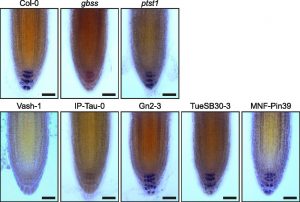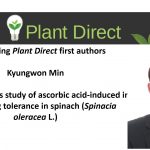Natural Variation in the Amylose Content of Starch
Starch is the major storage carbohydrate in plants. It occurs as semi-crystalline, insoluble granules consisting of two Glc polymers: amylopectin and  amylose. Amylopectin, the major polymer, gives rise to the semi-crystalline matrix of the granule. Amylose is believed to reside in amorphous regions within the granule matrix. Amylose is not necessary for granule formation: mutant plants lacking amylose form essentially normal semi-crystalline granules. The enzyme responsible for amylose synthesis, GRANULE-BOUND STARCH SYNTHASE (GBSS), differs from the other isoforms of starch synthase that synthesize amylopectin in being exclusively located within starch granules. Amylose makes up approximately 10% to 30% (w/w) of all the natural starches thus far examined, but mutants of crop and model plants that produce amylose-free starch are generally indistinguishable from their wild-type counterparts with respect to growth, starch content, and granule morphology. To explore the extent of variation in the amylose content of starch in a wild species, Seung et al. (10.1104/pp.19.01062) used the genetic resources from the 1,135 sequenced natural accessions of Arabidopsis to identify a subset of accessions containing polymorphisms in GBSS, which proved to encompass unprecedented intraspecies variation in amylose content. The authors identified 18 accessions that are predicted to have polymorphisms in GBSS that affect protein function, and five of these accessions produced starch with no or extremely low amylose. Three mechanisms were elucidated by which GBSS sequence variation led to different amylose contents: (1) altered GBSS abundance, (2) altered GBSS activity, and (3) altered affinity of GBSS for binding PROTEIN TARGETING TO STARCH1—a protein that targets GBSS to starch granules. These findings demonstrate that amylose in leaves is not essential for the viability of some naturally occurring Arabidopsis genotypes, at least over short timescales and under some environmental conditions and open an opportunity to explore the adaptive significance of amylose.
amylose. Amylopectin, the major polymer, gives rise to the semi-crystalline matrix of the granule. Amylose is believed to reside in amorphous regions within the granule matrix. Amylose is not necessary for granule formation: mutant plants lacking amylose form essentially normal semi-crystalline granules. The enzyme responsible for amylose synthesis, GRANULE-BOUND STARCH SYNTHASE (GBSS), differs from the other isoforms of starch synthase that synthesize amylopectin in being exclusively located within starch granules. Amylose makes up approximately 10% to 30% (w/w) of all the natural starches thus far examined, but mutants of crop and model plants that produce amylose-free starch are generally indistinguishable from their wild-type counterparts with respect to growth, starch content, and granule morphology. To explore the extent of variation in the amylose content of starch in a wild species, Seung et al. (10.1104/pp.19.01062) used the genetic resources from the 1,135 sequenced natural accessions of Arabidopsis to identify a subset of accessions containing polymorphisms in GBSS, which proved to encompass unprecedented intraspecies variation in amylose content. The authors identified 18 accessions that are predicted to have polymorphisms in GBSS that affect protein function, and five of these accessions produced starch with no or extremely low amylose. Three mechanisms were elucidated by which GBSS sequence variation led to different amylose contents: (1) altered GBSS abundance, (2) altered GBSS activity, and (3) altered affinity of GBSS for binding PROTEIN TARGETING TO STARCH1—a protein that targets GBSS to starch granules. These findings demonstrate that amylose in leaves is not essential for the viability of some naturally occurring Arabidopsis genotypes, at least over short timescales and under some environmental conditions and open an opportunity to explore the adaptive significance of amylose.



